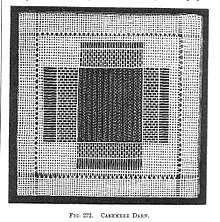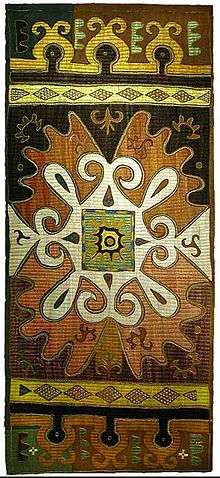Darning
Darning is a sewing technique for repairing holes or worn areas in fabric or knitting using needle and thread alone. It is often done by hand, but it is also possible to darn with a sewing machine. Hand darning employs the darning stitch, a simple running stitch in which the thread is "woven" in rows along the grain of the fabric, with the stitcher reversing direction at the end of each row, and then filling in the framework thus created, as if weaving. Darning is a traditional method for repairing fabric damage or holes that do not run along a seam, and where patching is impractical or would create discomfort for the wearer, such as on the heel of a sock.
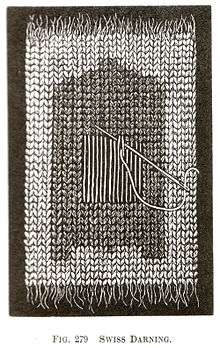
Darning also refers to any of several needlework techniques that are worked using darning stitches:
- Pattern darning is a type of embroidery that uses parallel rows of straight stitches of different lengths to create a geometric design.[2]
- Net darning, also called filet lace, is a 19th-century technique using stitching on a mesh foundation fabric to imitate lace.
- Needle weaving is a drawn thread work embroidery technique that involves darning patterns into barelaid warp or weft thread.
Darning cloth
In its simplest form, darning consists of anchoring the thread in the fabric on the edge of the hole and carrying it across the gap. It is then anchored on the other side, usually with a running stitch or two. If enough threads are criss-crossed over the hole, the hole will eventually be covered with a mass of thread.[1]:142
Fine darning, sometimes known as Belgian darning, attempts to make the repair as invisible and neat as possible. Often the hole is cut into a square or darn blends into the fabric.
There are many varieties of fine darning. Simple over-and-under weaving of threads can be replaced by various fancy weaves, such as twills, chevrons, etc., achieved by skipping threads in regular patterns.
Invisible darning is the epitome of this attempt at restoring the fabric to its original integrity. Threads from the original weaving are unraveled from a hem or seam and used to effect the repair. Invisible darning is appropriate for extremely expensive fabrics and items of apparel.
In machine darning, lines of machine running stitch are run back and forth across the hole, then the fabric is rotated and more lines run at right angles. This is a fast way to darn, but it cannot match the effects of fine darning.[1]:145
Darning tools
There are special tools for darning socks or stockings:
- A darning egg is an egg-shaped tool, made of stone, porcelain, wood, or similar hard material, which is inserted into the toe or heel of the sock to hold it in the proper shape and provide a foundation for repairs. A shell of the tiger cowry Cypraea tigris, a popular ornament in Europe and elsewhere, was also sometimes used as a ready-made darning egg.
- A darning mushroom is a mushroom-shaped tool usually made of wood. The sock is stretched over the curved top of the mushroom, and gathered tightly around the stalk to hold it in place for darning.
- A darning gourd is a hollow dried gourd with a pronounced neck. The sock can be stretched over the full end of the gourd and held in place around the neck for darning.
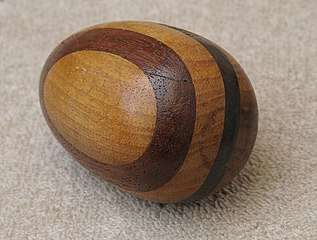 Darning egg, early 20th century
Darning egg, early 20th century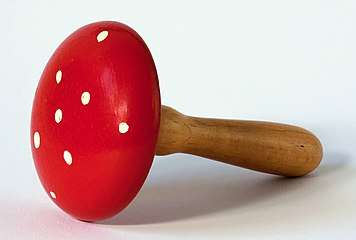 Darning mushroom
Darning mushroom
Pattern darning

Pattern darning is a simple and ancient embroidery technique in which contrasting thread is woven in-and-out of the ground fabric using rows of running stitches which reverse direction at the end of each row. The length of the stitches may be varied to produce geometric designs. Traditional embroidery using pattern darning is found in Africa, Japan, Northern and Eastern Europe, the Middle East, Mexico and Peru.[4]
Pattern darning is also used as a filling stitch in blackwork embroidery.[2]
Across the world
Iran
Rofoogari is an old traditional skill or technique used to fix or repair historic textiles and woven materials and fabrics in Iran. Having an old history in weaving and textile making, the culture of rofoo, or "vasleh- Pineh" arose among the poor and unwealthy communities. They used patches to cover the damaged parts and go over the space by running stitches and sometimes decorative ones. In some communities due to lack of resources, they repeated the process as they needed, which is why we find very colorful, different patterned vasleh- pineh in galleries and museums.
India
Rafoogari is the name for art of darning in India and neighbouring countries of the subcontinent where this art of healing the cloth is used for emotional and historical reasons too. Though is a social shame associated with wearing restored clothes but this art has been used by highly skilled "rafoogars" to restore some priceless clothes such as Pashmina shawl, silks, woolen clothes and even fine cotton, etc. Kashmiris are considered the best rafoogars, who have imparted their knowledge to the artists all over India. Rafoogars still exist across India.[5]
Foundation of Indian Contemporary Art has been trying to preserve this art and some artists in India still practice it as hereditary art for over 16 generations.[6][7][8]
In popular culture
- In the Beatles' 1966 song "Eleanor Rigby", McCartney sings about the priest Father McKenzie: "Look at him working, darning his socks/ In the night when there's nobody there."[9]
- In the classic episode of "I Love Lucy" titled "Lucy Does a TV Commercial", Lucy Ricardo is seen darning a sock for Ricky in the episode’s opening scene.
See also
- Mending
- Conservator-restorer
- Conservation and restoration of paintings
- Conservation and restoration of textiles
- Kintsugi
- Restoration (cultural heritage)
References
- Caulfeild, S.F.A.; Saward, Blanche C. (1885). "Darn". The Dictionary of Needlework: An Encyclopaedia of Artistic, Plain, and Fancy Needlework. 2 (2nd ed.). London: L. Upcott Gill. pp. 142–145 – via Internet Archive.
- Colton, Virginia, ed. (1979). Reader's Digest Complete Guide to Needlework. Pleasantville, NY: Reader's Digest Association. pp. 46–47, 57. ISBN 0-89577-059-8. OCLC 5676532 – via Google Books.
- Christie, Grace (September 1906). "Chapter 9: Methods of Work (continued)". Embroidery and Tapestry Weaving. The Artistic Crafts Series of Technical Handbooks. New York: Macmillan. p. 198 – via Internet Archive.
- Simon, Sally (4 March 2008) [1982]. "Pattern Darning". Needle Pointers. Vol. 10 no. 1. American Needlepoint Guild. Archived from the original on 27 December 2005. Retrieved 17 December 2005.
- Rafoogari: Art of darning, Deccan herald, 13 April 2013.
- New Delhi: Mapping a forgotten tradition, LiveMint, 28 April 2017.
- Journey of a shawl , The Statesman, 19 April 2018.
- The fabric of hope, The Hindu, 25 Aug 2016.
- Everett, Walter (21 October 1999). "The Beatles as Musicians: Revolver Through the Anthology". Oxford University Press. Retrieved 21 October 2017 – via Google Books.
Further reading
- Reader's Digest Oxford Dictionary p. 1001.CS.
- Coates, Lydia Trattles (1917). "Chapter 11—Darning and Patching". American Dressmaking Step by Step. New York: Pictorial Review Company. pp. 188–192 – via Google Books.
- "Embroidery or Decoration". How to Become an "Expert Knitter". Studio Knits. n.d. Swiss darning, or duplicate stitch.
